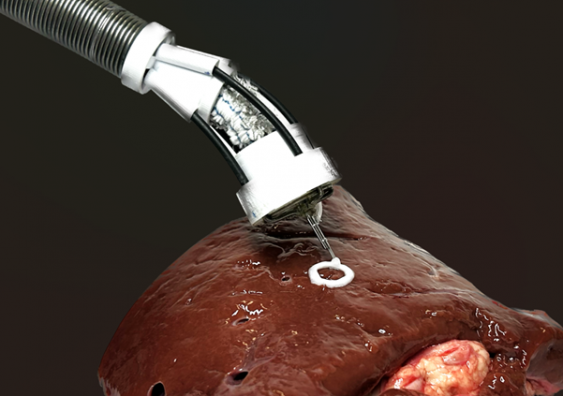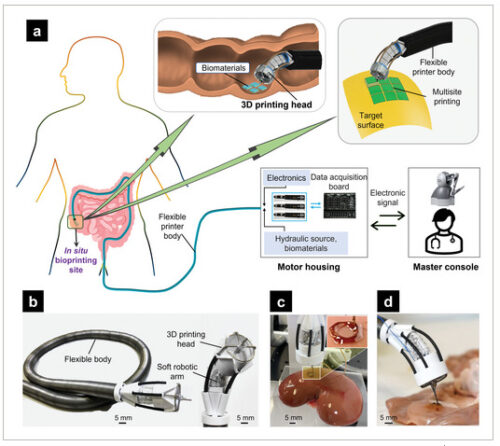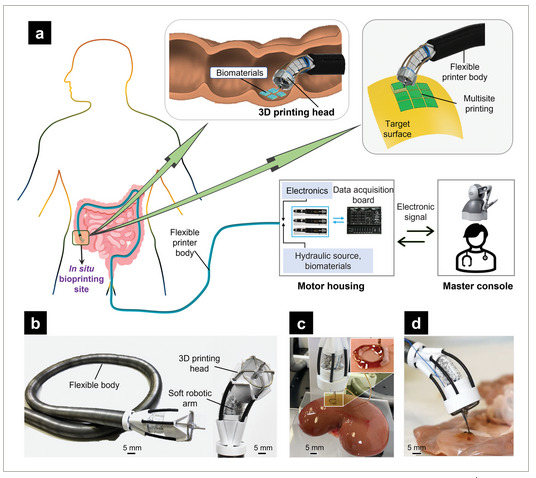UNSWの研究者は、生きた細胞を内臓に直接3Dプリントすることができ、オールインワンの内視鏡手術ツールとして使用できる可能性のあるプロトタイプデバイスを発表しました。 UNSW researchers unveil prototype device that can directly 3D print living cells onto internal organs and potentially be used as an all-in-one endoscopic surgical tool.
2023-02-28 ニューサウスウェールズ大学(UNSW)
3Dバイオプリンティングは、バイオインクからバイオ医療部品を作成して自然な組織状態の構造を形成するプロセスで、研究用途や新薬の開発に用いられている。今回の研究では、3Dバイオプリンティングを内部器官に直接提供できる小型柔軟なプリンターが開発され、切開や自然な開口部を介して人体内の難しい箇所にアクセスできることが示された。チームは、人工結腸の中でこの装置をテストし、また豚の腎臓の表面に異なる形状のさまざまな材料を3Dプリントしています。
この装置の特徴は、3軸の印刷ヘッドをソフトロボットアームの先端に直接取り付けたことである。このプリントヘッドは、柔らかい人工筋肉で構成されている
研究者らは、この新技術が5年から7年以内に医療従事者によって使用される可能性があると述べている。
詳細はAdvanced Scienceに発表された論文に記載されています。
<関連情報>

その場3Dバイオプリンティングと内視鏡手術のための先進的なソフトロボットシステム Advanced Soft Robotic System for In Situ 3D Bioprinting and Endoscopic Surgery
Mai Thanh Thai, Phuoc Thien Phan, Hien Anh Tran, Chi Cong Nguyen, Trung Thien Hoang, James Davies, Jelena Rnjak-Kovacina, Hoang-Phuong Phan, Nigel Hamilton Lovell, Thanh Nho Do
Advanced Science Published: 19 February 2023
DOI:https://doi.org/10.1002/advs.202205656

Abstract
Three-dimensional (3D) bioprinting technology offers great potential in the treatment of tissue and organ damage. Conventional approaches generally rely on a large form factor desktop bioprinter to create in vitro 3D living constructs before introducing them into the patient’s body, which poses several drawbacks such as surface mismatches, structure damage, and high contamination along with tissue injury due to transport and large open-field surgery. In situ bioprinting inside a living body is a potentially transformational solution as the body serves as an excellent bioreactor. This work introduces a multifunctional and flexible in situ 3D bioprinter (F3DB), which features a high degree of freedom soft printing head integrated into a flexible robotic arm to deliver multilayered biomaterials to internal organs/tissues. The device has a master-slave architecture and is operated by a kinematic inversion model and learning-based controllers. The 3D printing capabilities with different patterns, surfaces, and on a colon phantom are also tested with different composite hydrogels and biomaterials. The F3DB capability to perform endoscopic surgery is further demonstrated with fresh porcine tissue. The new system is expected to bridge a gap in the field of in situ bioprinting and support the future development of advanced endoscopic surgical robots.



